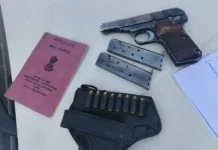NEW DELHI, 12 Jul: Seconds before Air India flight 171 crashed while ascending from Ahmedabad, the fuel control switches of both its engines were cut off, a preliminary investigation report said on Saturday, suggesting a catastrophic pilot error in the cockpit of the Boeing 787 Dreamliner.
The Airlines Pilots Association of India raised the issue with the report, saying the investigation is “shrouded in secrecy,” appears to be biased against the pilot and has come to a conclusion hastily.
A 15-page preliminary investigation report into the disaster revealed fuel-control switches of the two engines moved from the “run” to the “cutoff” position, within the space of one second, leading to immediate loss of altitude.
In the cockpit voice recording, one pilot is heard asking the other why he cut off the fuel. The other denied having done so.
The report by Aircraft Accident Investigation Bureau (AIIB), released early on Saturday, neither concluded any reason for the switches moving nor apportioned explicit blame for the crash.
It also did not identify the pilots in the voice recording. But it also said no fault was found in the aircraft, leaving only the possibility of pilot error as the cause.
At the controls was First Officer Clive Kunder, 32, while Sumeet Sabharwal, a veteran with 30 years of experience at Air India, was the senior cockpit occupant in command monitoring the flight.
The report, however, referenced a 2018 airworthiness bulletin by the US Federal Aviation Administration that said fuel switches had been installed on Boeing 737s, a smaller model, “with the locking feature disengaged”. The locking mechanism was similar on various Boeing aeroplane models, including certain 787s, it said.
Air India did not carry out inspections recommended in the 2018 FAA advisory on fuel control switch safety, as the bulletin was classified as “non-mandatory”, the report said.
It wasn’t immediately clear if this had any link to the accident. The report provided the first detailed account of the fateful 32 seconds between takeoff in Ahmedabad and the crash into a medical college hostel just outside the airport perimeter, killing all but one of the 242 onboard and another 19 on the ground in the deadliest aviation accident in a decade.
The report did not provide any clues to why and by whom the two fuel switches were moved to a cut-off position as the plane nosed into the air, starving the two engines of the thrust needed for the lift. It ruled out any bird hit or fuel contamination.
According to a chronology laid out in the report, both fuel cutoff switches moved from RUN to CUTOFF, one second apart, almost immediately after takeoff. Ram Air Turbine (RAT) pump was deployed to supply hydraulic power as both engines fell below the minimum idle rate.
About 10 seconds later, Engine 1 fuel cutoff switch moved to its so-called RUN position, followed by Engine 2 four seconds later.
The pilots managed to relight both engines, but only Engine 1 recovered while Engine 2 failed to build up enough power again to reverse deceleration. One of the pilots issued a “Mayday, Mayday, Mayday” distress call, but before air traffic controllers could get a response about what had gone wrong, the plane crashed just outside the Ahmedabad airport boundary having grazed some trees before plunging into a hostel packed with students.
The time between the takeoff and the crash was only 32 seconds. The preliminary report recommended no action for now for the operators of Boeing 787-8 planes. In a statement, Air India said that it “stands in solidarity with the families and those affected” and “[continues] to mourn the loss” of those killed in the accident.
The June 12 accident was India’s worst aviation disaster in almost three decades and the industry’s deadliest in 11 years, as well as the first fatal accident involving a Boeing Dreamliner.
The investigation was conducted with assistance from the UK’s Air Accident Investigation Branch and the US National Transportation Safety Board.
Aviation experts have said it is difficult for pilots to inadvertently move the fuel switches, as there is a little mechanical gate built into the switch. Switches need to be lifted up over this little gate to shut off supply. They also asked why the report made no reference to cockpit camera footage.
The AAIB is gathering additional details based on initial leads and data downloaded from the forward Enhanced Airborne Flight Recorder (EAFR) is being analysed.
“At this stage of investigation, there are no recommended actions to B787-8 and/or GE GEnx-1B engine operators and manufacturers,” the report said. (PTI)



